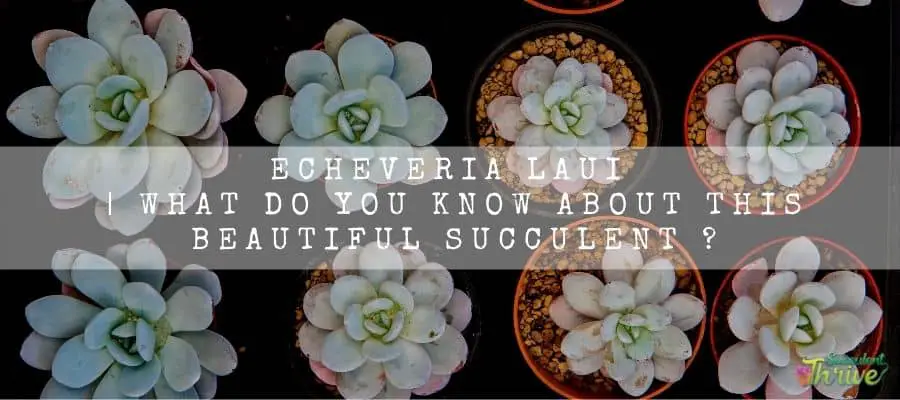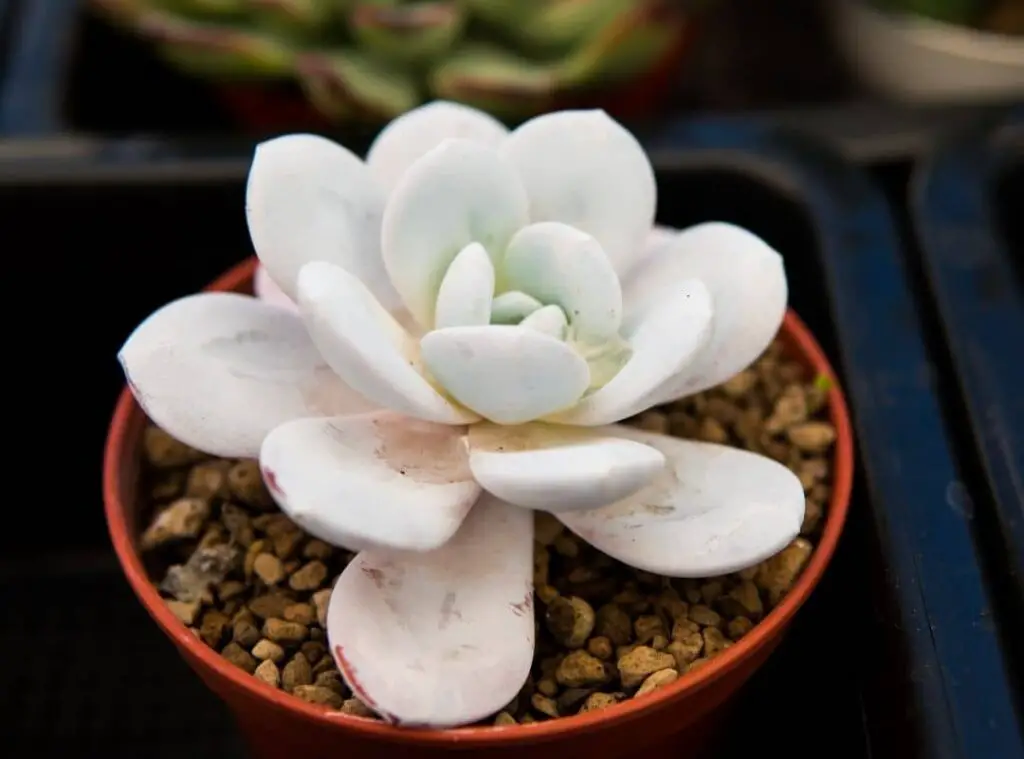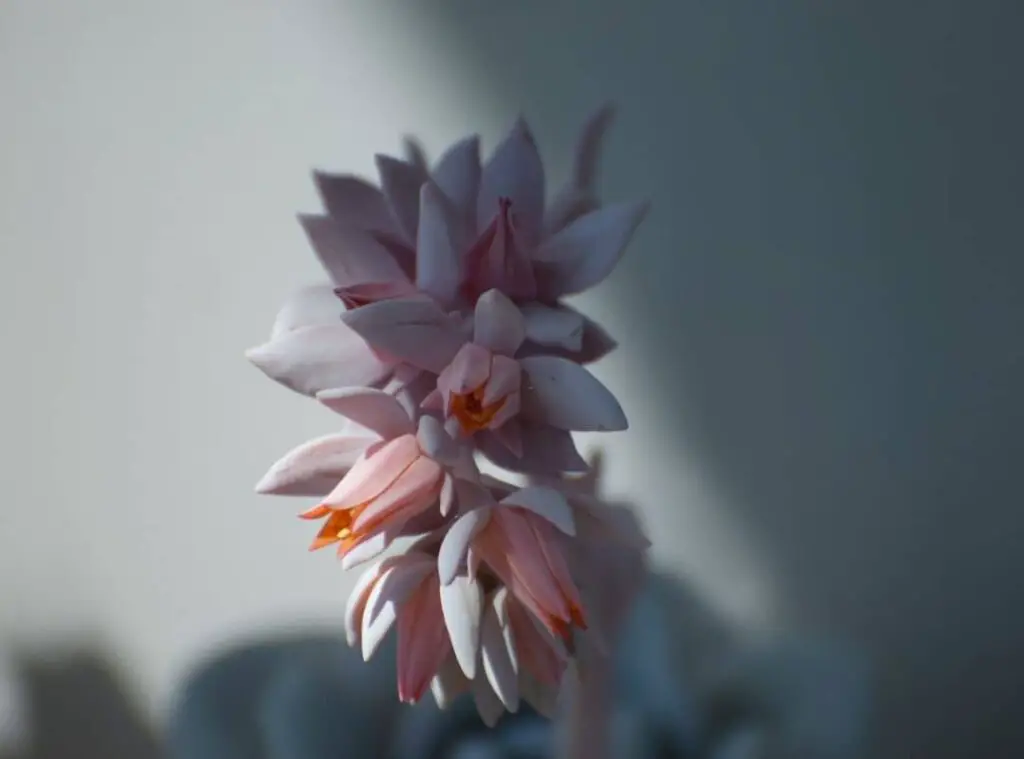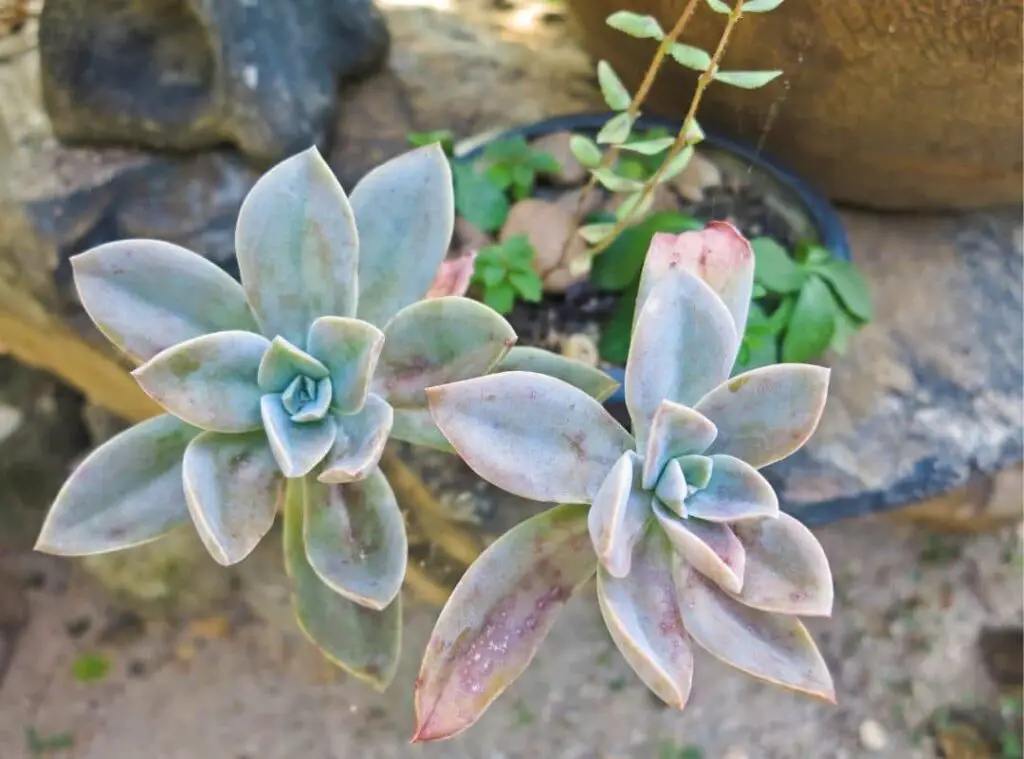Echeveria Laui plants are quite famous for their light blue color. On top of that their magnificent flower blossoming is one more interesting feature of these plants. If you are a succulent lover, Echeveria Laui plants would be a great pick for you.
Furthermore, Echeveria Laui plants require only a minimum maintenance from you. So many people tend to grow them due to this characteristic.
Since this is a trendy plant among gardeners, I am going to cover how to look after these beauties well, so that they can grow to their fullest and thrive well.

How do I identify Echeveria laui?
You could identify the Echeveria Laui plants from its leaves and those would be blue, gray to white in color. In addition to that, their foliage comprises densely covered farina layers as well.
Moreover, you could spot underneath these leaves the glaucous coating in red. Echeveria Laui plants usually grow without branching.
In addition to these features, you could use their flowering activity to identify the Echeveria Laui plants. They would usually form in the base of the plants and the flowers would be pink or peach color.
Size of the plant
Echeveria Laui plants would usually reach a maximum height of 6 inches, and they would take a plenty of years to reach this size. Further their rosettes would be 5 inches in diameter.
Growth rate
Echeveria Laui plants usually grow at a slow rate.
One look care guide
| Botanical Name | Echeveria Laui |
| Common Name | La roseta |
| Plant Type | Succulents |
| Mature Size | Height of 6 inches, Rosettes would be 5 inches in diameter. |
| Sun Exposure | Full sunlight to partial shade |
| Soil Type | Well draining , sandy |
| Soil pH | 6.0 |
| Bloom Time | Spring |
| Flower Color | Pink, peach |
| Hardiness Zones | USDA hardiness zones 9b-11b |
| Native Area | Mexico |
| Toxicity | Non toxic |
| Average price | USD 6 |
How do you take care of Echeveria laui?
Light Requirement
Echeveria Laui plants could perform well given that they get full sunlight.
Literally when you grow them as indoor plants, grow them in a sunny spot at your home which could possibly be a window most of the time.
However, ensure that the plants do not receive direct sunlight there though. . If you do so, it could badly impact your plants.
Further if you have grown them as indoor plants for some time and, if you had given them moderate sunlight level, you could consider shifting them outdoors particularly during spring.
Having said that, you should not expose them to full sunlight at once. Failing to do so will result in sunburns in the plants.
It could be so irritating as those sunburns could remain on the foliage permanently if you come across a severe burn. Best is to get rid of them and allow them to grow freshly.
Temperature and humidity
A temperature range of 65- 70 degrees Fahrenheit (18- 21 degrees Celsius) would be ideal to grow the Echeveria Laui plants.
They could withstand a temperature range of 50 degrees Fahrenheit during winter. Refrain in locating these plants near drafts and for colder temperature levels.
On the other hand, excessive humidity levels could also create trouble for them. If you grow them indoors, they can perform well in indoor temperatures.
However, this is not the type of plant which you could keep in a place like a bathroom due high humidity level.

Is it cold hardy?
Echeveria Laui plants are not cold hardy plants.
USDA Hardiness Zone
Echeveria Laui plants are hardy in USDA hardiness zones 9b-11b
Watering Requirement
Watering the Echeveria Laui plants properly is quite important when taking care of them well.
Keep in mind that they do not prefer to be in waterlogged situations no matter where you place them be it indoors or outdoors.
Having said that, it does not mean that you need to keep the plants in dry conditions either.
You could consider watering them more often in seasons like spring and summer as these are the seasons where they grow actively.
However, ensure that you have grown them in a well-draining soil mix as watering them properly and growing them in a well-draining soil mix go hand in hand.
Just to touch on the watering frequencies in each season, you could water them once a month in winter and you may water them biweekly during spring and summer whilst ensuring that your soil is dry from the previous watering session.
Water the soil and not the plant. Do not ever water the rosettes of the plants since it could be harmful.
Once you complete watering them, ensure that all excess water is drained, and nothing is remaining in the soil medium.
Soil Requirement Type / pH
It is mandatory to provide a well-draining soil mix to grow the Echeveria Laui plants. Ideally you may grow them in a cactus soil mix or in a succulent soil mix.
Those soil types would be healthy for an optimal growth in the plants. Consider adding elements such as coarse sand to fasten the draining of the soil mix.
When it comes to the right ph. level of the soil mix, it could be ideally 6.0.
Pot size Potting and Repotting
You may proceed with a terracotta pot or with a clay pot to grow them as they are porous material and excess moisture will evaporate faster. Further your pot needs to have at least one draining hole.
When it comes to repotting, the best season to conduct repotting would be the warmer season.
Furthermore, you need to repot them once you freshly purchase them from the nurseries as well. You need to simply adhere to the general succulent repotting practices when repotting them.
Where to Plant
If you are wondering where to plant your beloved Echeveria Laui plants, you should first undoubtedly go ahead with a spot where they can receive full sunlight.
As such, no matter where you plant them, you should proceed with the brightest sunny spot in your space.
However, when you grow them in your garden, make sure that the plants get full sunlight to partial sunlight.
In terms of the temperatures, they would prefer to grow in warmer temperature levels as aforesaid.
If you live in USDA zones 9a-11b , you could grow them as outdoor plants and if you live somewhere you get much colder weather conditions, you need to grow them as indoor plants.
You may bring the plants outdoors during spring and summer though. Apart from the above, ensure that you grow them in a pot type which is mentioned above.
Fertilizer and time of year
You could go ahead with a controlled release fertilizer to feed them. Consider feeding them during the beginning of their growth season.
Instead of a controlled release fertilizer, you may go ahead with a liquid fertilizer as well. You could consider feeding them monthly.
Echeveria Laui plants grow in soil mediums which are quite low in nutritional levels. However, when you apply the additional fertilizers, it would be effective in stimulating the growth of the plants.
Dormancy
Echeveria Laui plants’ dormancy would be in winter. You need to suspend feeding them and watering them during this season.
Flowering
Echeveria Laui plants could produce flowers multiple times in a year. This is what you call, polycarpic. However, they consume a lot of energy for flower blossoming.
Hence, I recommend cutting off the flower’s stalks of the older plants unless they would be attractive towards the pests.
Flower color would be either peach or pink. They would usually arise in the base of the plants.

Other plants Pairs Well With
Echeveria Laui plants could grow well with Kalanchoes, Graptoveria, Haworthia, Pachyphytum Oviferum and Aeonium plants as well.
Toxicity
Echeveria Laui plants are nontoxic plants for pets as well as for humans . Having said that, I do not encourage eating them.
Common bugs and illnesses
You may encounter pests’ attacks from mealybugs, mites and from thrips when growing these plants.
If you do not remove the older leaves, older flower stalks, those conditions would be welcoming towards these pests.
However, Echeveria Laui plants could resist pests’ attacks in general as they have a farina layer which could defend the plants from the pests biting.
However if you could come across any you may treat them by using neem oil and try an insecticidal soap just like you do with the other succulents.
Special Care tips
As explained right in the beginning in the article, Echeveria Laui plants could be easily maintained.
However, do not forget that you should not expose them to too much water at any given point of time as it could pave the way for diseases such as root rot.
Apart from that, it would be better if you could remove all dead leaves and spent blooms and older flower stalks from the plants so that it would stimulate the new growth of the plants.
Ensure that you do not do any faults in watering them. if you under water them, it would result in the plant drooping, shriveling and wilting of the leaves.
As such, stick to aforesaid guiltiness and ensure a proper watering for the plants.
Finally make it a habit to spend some time and inspect your plants on a weekly basis so that you could see if there are any early signs of any upcoming disease.

How to propagate Echeveria laui
You could use the Echeveria Laui plant’s leaves as well as their seeds to conduct propagation.
However, try to avoid doing the seeds method as these are some slow growing plants and you cannot rely on its success.
If you still wish to try that method, you need to plant them in a well-draining soil mix and stay patient until they form roots.
Secondly, if you are trying the leaf propagation method, first you need to separate a lead from a healthy-looking main stem.
To separate the leaves, you could simply shake it side to side so that the leaf will fall. After that you could simply lay them on a soil layer and expose them in a bright sunlight area.
Do not leave them exposed for direct sunlight though.
You will see how they come up with roots within two to three weeks’ time. You could lightly water them now.
In another one month’s time, you will spot how they form a little rosette at the leaf edges. As the time passes, the older leaves will die, and the new plantlets will grow as free plants.
Echeveria laui plant benefits
They are useful to grow in rock gardens. Moreover, you may consider growing them as individual plants in pots too.
Not only that but also, they would be great picks for rock ground covers, borders and for beds as well.
Finally
So, to sum up, Echeveria Laui plants require only an easy maintenance from you and if you manage to fulfil the main necessities of the plants, they will thrive well and grow to their fullest. Happy gardening !
Read More : Echeveria Ice Green | We Give14 Rock Solid Care Facts | Echeveria Elegans Alba | 14 Super Cool Succulent Care Facts | Echeveria Raindrops Succulent | 14 Clear And Unbiased Care Facts | Echeveria Perle Von Nurnberg Propagation | 5 Effective Methods |
